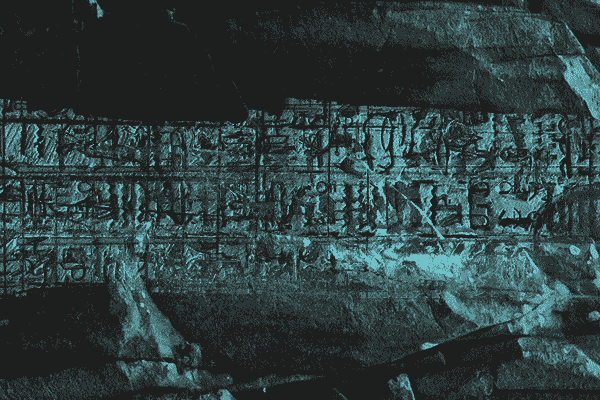| Boreal Herald Tribune | |
| February 1928 | Five Cents |
The Call of Cthulhu |
|
| By Howard Phillips Lovecraft | |
| Found Among the Papers of the Late Francis Wayland Thurston, of Boston | |
Of such great powers or beings there may be conceivably a survival... a survival of a hugely remote period when... consciousness was manifested, perhaps, in shapes and forms long since withdrawn before the tide of advancing humanity... forms of which poetry and legend alone have caught a flying memory and called them gods, monsters, mythical beings of all sorts and kinds...
The Horror in Clay — Part 2
The bas-relief was a rough rectangle less than an inch thick and about five by six inches in area; obviously of modern origin. Its designs, however, were far from modern in atmosphere and suggestion; for although the vagaries of cubism and futurism are many and wild, they do not often reproduce that cryptic regularity which lurks in prehistoric writing. And writing of some kind the bulk of these designs seemed certainly to be; though my memory, despite much familiarity with the papers and collections of my uncle, failed in any way to identify this particular species, or even to hint at its remotest affiliations.

Above these apparent hieroglyphics was a figure of evidently pictorial intent, though its impressionistic execution forbade a very clear idea of its nature. It seemed to be a sort of monster, or symbol representing a monster, of a form which only a diseased fancy could conceive.
If I say that my somewhat extravagant imagination yielded simultaneous pictures of an octopus, a dragon, and a human caricature, I shall not be unfaithful to the spirit of the thing. A pulpy, tentacled head surmounted a grotesque and scaly body with rudimentary wings; but it was the general outline of the whole which made it most shockingly frightful. Behind the figure was a vague suggestion of a Cyclopean architectural background.
The writing accompanying this oddity was, aside from a stack of press cuttings, in Professor Angell's most recent hand; and made no pretence to literary style. What seemed to be the main document was headed "Cthulhu Cult" in characters painstakingly printed to avoid the erroneous reading of a word so unheard-of. The manuscript was divided into two sections, the first of which was headed "1925—Dream and Dream Work of H. A. Wilcox, 7 Thomas St., Providence, R.I.", and the second, "Narrative of Inspector John R. Legrasse, 121 Bienville St., New Orleans, La., at 1908 A. A. S. Mtg.—Notes on Same, and Prof. Webb's Acct."
The other manuscript papers were all brief notes, some of them accounts of the queer dreams of different persons, some of them citations from theosophical books and magazines (notably W. Scott-Elliot's Atlantis and the Lost Lemuria), and the rest comments on long-surviving secret societies and hidden cults, with references to passages in such mythological and anthropological source-books as Frazer's Golden Bough and Miss Murray's Witch-Cult in Western Europe. The cuttings largely alluded to outré mental illnesses and outbreaks of group folly or mania in the spring of 1925.
The first half of the principal manuscript told a very peculiar tale. It appears that on March 1st, 1925, a thin, dark young man of neurotic and excited aspect had called upon Professor Angell bearing the singular clay bas-relief, which was then exceedingly damp and fresh.
His card bore the name of Henry Anthony Wilcox, and my uncle had recognised him as the youngest son of an excellent family slightly known to him, who had latterly been studying sculpture at the Rhode Island School of Design and living alone at the Fleur-de-Lys Building near that institution. Wilcox was a precocious youth of known genius but great eccentricity, and had from childhood excited attention through the strange stories and odd dreams he was in the habit of relating.
He called himself "psychically hypersensitive", but the staid folk of the ancient commercial city dismissed him as merely "queer". Never mingling much with his kind, he had dropped gradually from social visibility, and was now known only to a small group of aesthetes from other towns. Even the Providence Art Club, anxious to preserve its conservatism, had found him quite hopeless.
On the occasion of the visit, ran the professor's manuscript, the sculptor abruptly asked for the benefit of his host's archaeological knowledge in identifying the hieroglyphics on the bas-relief. He spoke in a dreamy, stilted manner which suggested pose and alienated sympathy; and my uncle shewed some sharpness in replying, for the conspicuous freshness of the tablet implied kinship with anything but archaeology.
Young Wilcox's rejoinder, which impressed my uncle enough to make him recall and record it verbatim, was of a fantastically poetic cast which must have typified his whole conversation, and which I have since found highly characteristic of him. He said, "It is new, indeed, for I made it last night in a dream of strange cities; and dreams are older than brooding Tyre, or the contemplative Sphinx, or garden-girdled Babylon."
It was then that he began that rambling tale which suddenly played upon a sleeping memory and won the fevered interest of my uncle. There had been a slight earthquake tremor the night before, the most considerable felt in New England for some years; and Wilcox's imagination had been keenly affected. Upon retiring, he had had an unprecedented dream of great Cyclopean cities of titan blocks and sky-flung monoliths, all dripping with green ooze and sinister with latent horror.

Hieroglyphics had covered the walls and pillars, and from some undetermined point below had come a voice that was not a voice; a chaotic sensation which only fancy could transmute into sound, but which he attempted to render by the almost unpronounceable jumble of letters, "Cthulhu fhtagn".